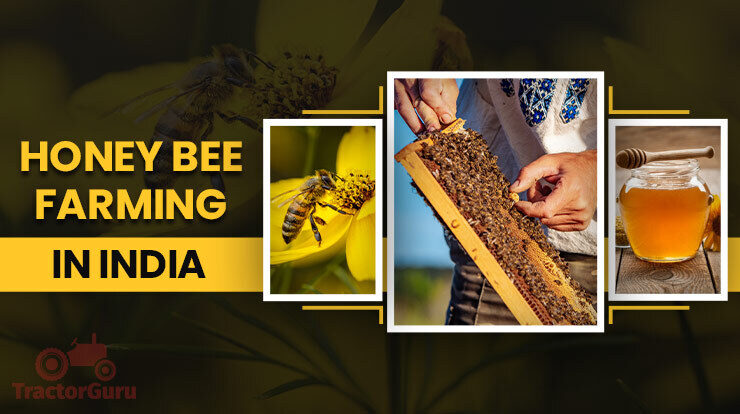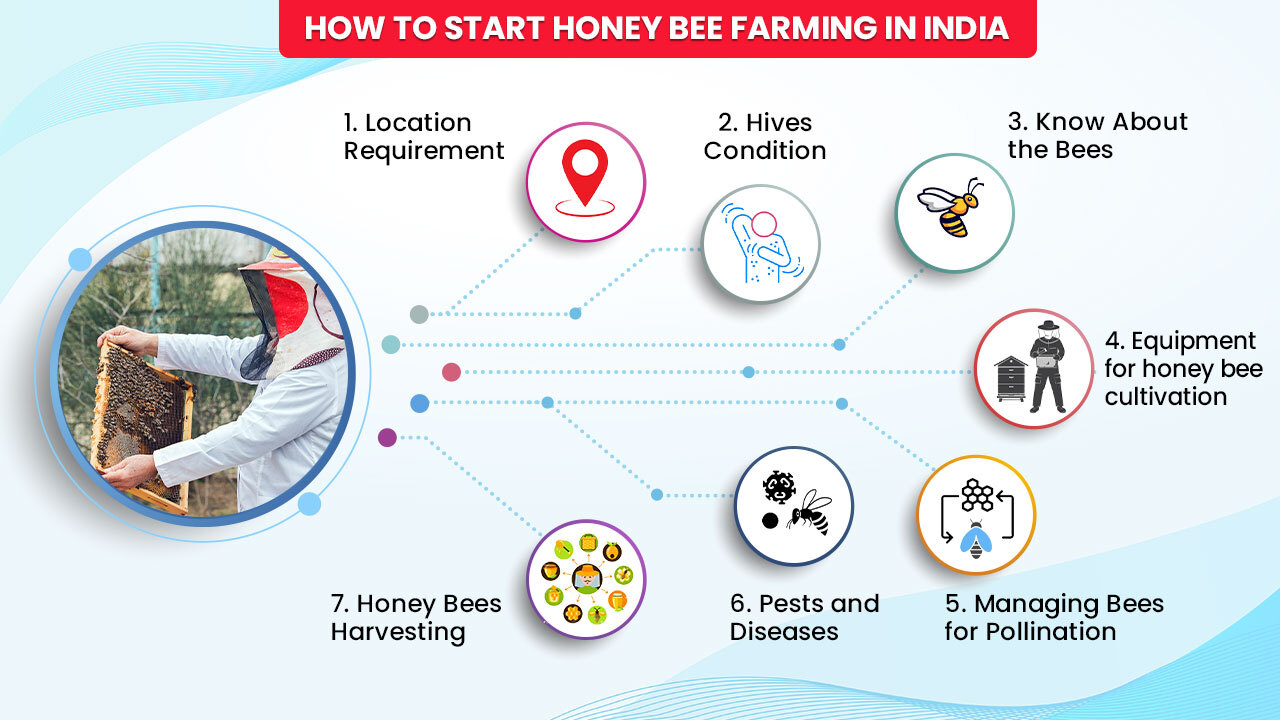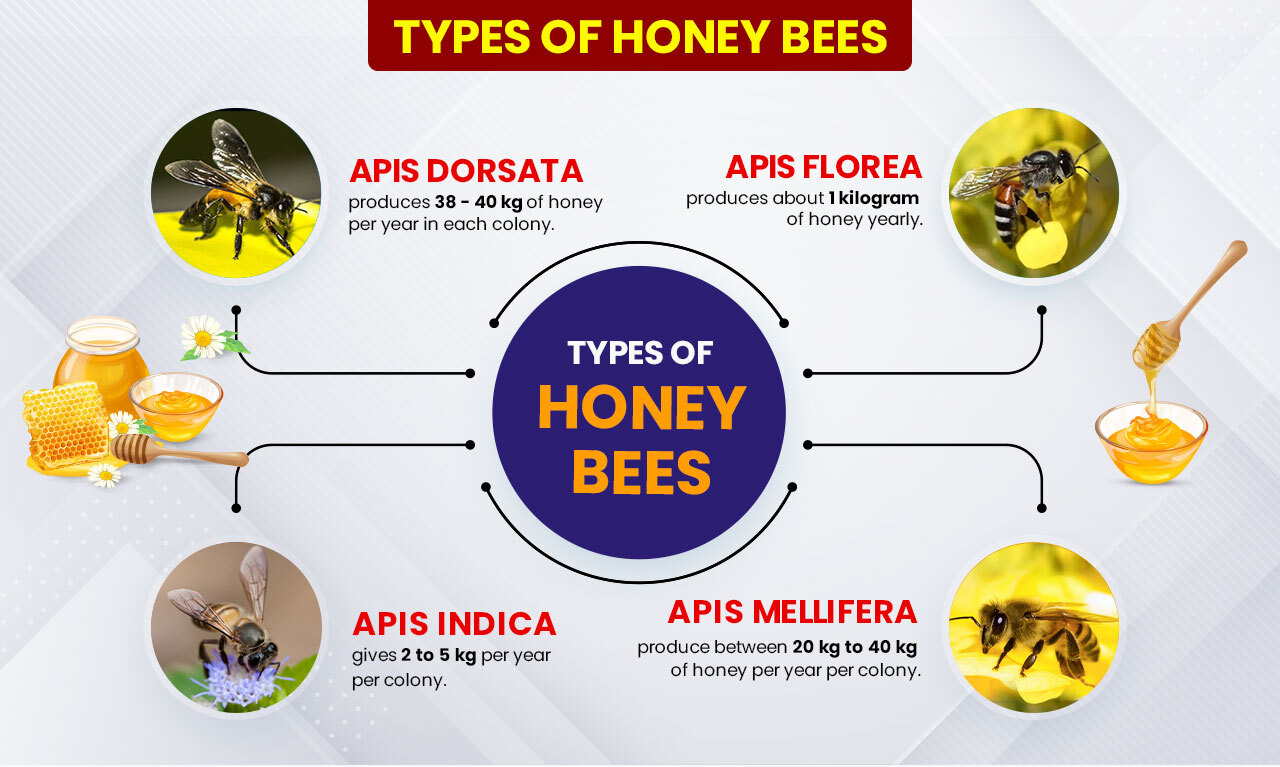Honey Bee Farming in India – Guide to Start a Honey Bee Farm (Beekeeping)

Honey Bee farming is the practice of maintaining and keeping bees and their hives. It is a type of business that involves nurturing and caring for bees to obtain bee products such as beeswax, honey, flower pollen, royal jelly and bee pollen. Beekeepers are also known as apiarists; the whole colony (workers, drones, and a queen) is called Apiary. Beekeeping or honey bee farming has become popular in recent years, and there is a great demand for raw honey, beeswax and royal jelly products.
Honey bee farming needs to be well-managed; so that the bees can be kept in optimum condition, healthy and disease-free. Good health and welfare of honey bee stocks are essential factors in this farming. It is widely believed that pollinator decline needs to be reversed. The honey bee farming industry is in a unique position to increase productivity and help improve crop yields through the provision of managed and targeted pollination services.
Apart from this, Honey Business start-up and growth require many considerations: availability of finance, capital costs, apiary sites, transport, equipment and handling, premises, processing facilities, staffing, storage, legislative requirements, etc.
The Major States in India For Honey Bee Farming
Punjab is the largest producer of rearing of honeybees in the country, with about 35,000 beekeepers transporting about 15,000 metric tonnes of honey. This accounts for more than 39% of the total honey production in the country. Maharashtra is the major region of natural honey production. There are facts and figures about India: The country has exported 59,999.24 metric tonnes of natural honey, worth Rs 716.13 crore / 96.77 million USD during the year 2020-21.
Profit from Bee Farming
Beekeeping helps farmers earn around Rs 3 crore annually. Beekeeping has now become a profitable business for various people across the country. By various statistics, we denote the information that you can get a yield of 40 kg per box. If you sell the honey for 100 rupees, you will get a total of 40 x 100 = 4000 rupees. The Total income from apiculture in agriculture is 40 x 4000 = 1,60,000. Therefore the honey bee farming business is too profitable for farmers.
How to Start Honey Bee Farming in India

First, we have to do beekeeping to produce the product from honey bees in India.
1. Location Requirement
When starting honey bee farming, first take the step to learn which type apiary farm should be used because it deserves some unique ideas. Bees will require sun, water, and a strong hive; during certain parts of the year, they may need food. If available, it is best to place the hive against a protected tree line or fence. Whereby bees will fly long distances to find enough pollen. Grasses, herbs, trees, flowers and weeds all produce pollen that is used by bees. You aren’t required to have a flourishing flower bed in the yard, but keeping a varied garden will help the bees get ample food.
2. Hives Condition
As a beekeeping beginner, your first year with a beehive will be a new experience at every point of the year. A colony looks and acts differently in spring, summer, fall and winter, and you may be seeing it all for the first time. We highly recommend starting your beekeeping in India adventure with two hives if you can afford it (both in money and time). You may not yet notice when something is off, but with two hives, you will notice that something is different between them. Consider also that last year more than 40% of all beekeepers did not survive the year. If you have one hive and it eliminates one in 40%, you will sadly start over the next year.
Types of Beehives
Skep: It is no longer used because honey is difficult to remove from the scape and this type of hive is hard to clean and can be unsanitary. Although it is no longer used, scapes can be a decorative addition to a collection of old farm equipment.
Top Bar: The top bar beehive looks like a pool used for animal feed. Bees make their combs by pulling them down from the wooden bar inside the top of the hive.
Langstroth: The Langstroth beehive is what you commonly see in many parts of the country. Langstroth consists of wooden boxes called supers, which are stacked on top of each other. Inside, the bees build their combs and fill the wax frame cells with honey hanging vertically inside the wooden boxes.
Warre: Warre hives are smaller than the Top Bar and Langstroth versions. These hives can be compared to a cross between a hollowed-out tree and a top bar hive.
3. Know About the Bees
You should be well-known about the bees. For this, understanding the colonies in the hive (workers, queen bees and drones), the purposes they serve, the impact on the environment, and the pests and diseases that can play a role in success. Then, buy good bees and start with the nucleus colony. You must start with the fewest colonies possible; two bee colonies will be sufficient. Then, after gaining experience, you can go for commercial honey bee rearing. Therefore we are elaborating on the types of honey bees for more information about the species of honey bees in India.
Types of Honey Bees

Apis Dorsata: Apis dorsata is also known as the rock bee. It is a giant bee that produces 38 – 40 kg of honey per year in each colony.
Apis Indica: Another name for Apis Indica is the Indian bee. It is easy to domesticate and is commonly used to produce honey. Apis Indica gives 2 to 5 kg per year per colony.
Apis Florea: Apis Florea is also known as Little Bee. Because it rarely stings, honey is easy to extract from its hive. As a result, each colony produces about 1 kilogram of honey yearly.
Apis Mellifera: Apis mellifera is also called the Italian bee. This species has a highly specialised dance routine to advertise food availability, and it stings less than the smaller bee. However, it can produce between 20 kg to 40 kg of honey per year per colony.
4. Equipment for Honey Bee Cultivation
Equipment conditions vary depending on the size of your operation, the number of colonies, and the type of honey you produce. However, the basic equipment you need is hive components, protective gear, smoker and hive equipment, and the tools you need to handle the honey harvest. A hive is a man-made structure in which a bee colony resides. A wide variety of hives have been developed over the years.
5. Managing Bees for Pollination
If you need bees for pollination, you may want to keep your bees. However, maintaining many strong hives throughout the year is difficult, and most growers prefer to rent hives. However, you should follow the below instructions.
- Place the hives too close to the source of the field to save the bee’s energy.
- Migrate colonies near the field after 10% flowering.
- Keep colonies at 3/ha for Italian bees and 5/ha for Indian bees.
- Colonies must have 5 – 6 frame strength of bees, sealed brood and young mate queen.
- Give enough space for storing pollen and honey.
6. Pests and Diseases
There are many diseases affecting bees in India. The major diseases affecting bees are Acarin and Nosema disease of adult bees and brood disease of larval stages. Therefore, the farmer must take advanced action to control specific pests and diseases. The farmer can contact the local agriculture department for their solution.
7. Honey Bees Harvesting
Most beekeepers harvest honey 2 to 3 times a season/ per year. Honey is usually harvested between mid-June to mid-September. How often you harvest depends on plant life and your local climate. Bad weather conditions, diseases and pests infiltrating your hives will also affect your harvesting schedule.
Facts of Bees
- Bees are the only insect on the earth that makes food that humans can eat.
- Honey contains natural preservatives, and bacteria cannot grow in it.
- Bees can recognize native plants as food sources more than foreign plants.
- The number of eggs given by the queen: 2,000 more per day.
- Bees are the most significant pollinators of flowers, vegetables and fruits. This is helpful in growing other plants.
We hope this blog is vital for you; hence more information regarding any agriculture sector, stay tuned with TractorGuru.
FAQS
Que. What is the honey bee farming project report?
Ans. The Beekeeping Project Report describes the activities of beekeeping and, ultimately, the cost of maintaining a small bee farm and the associated profits.
Que. Why is beekeeping beneficial for human beings?
Ans. Bee products help provide essential nutrition to humans and maintain their daily diet.
Que. What is stingless bee farming, and how is it beneficial?
Ans. Stingless native bees are considered primitive species that produce only small amounts of honey. However, it is of importance in the pollination of various food crops.
Que. What will happen if there are no bees?
Ans. It can be assumed that if there are no bees, the environment and its humans will disintegrate.
Related Blog:
Duck Farming Practice in India



